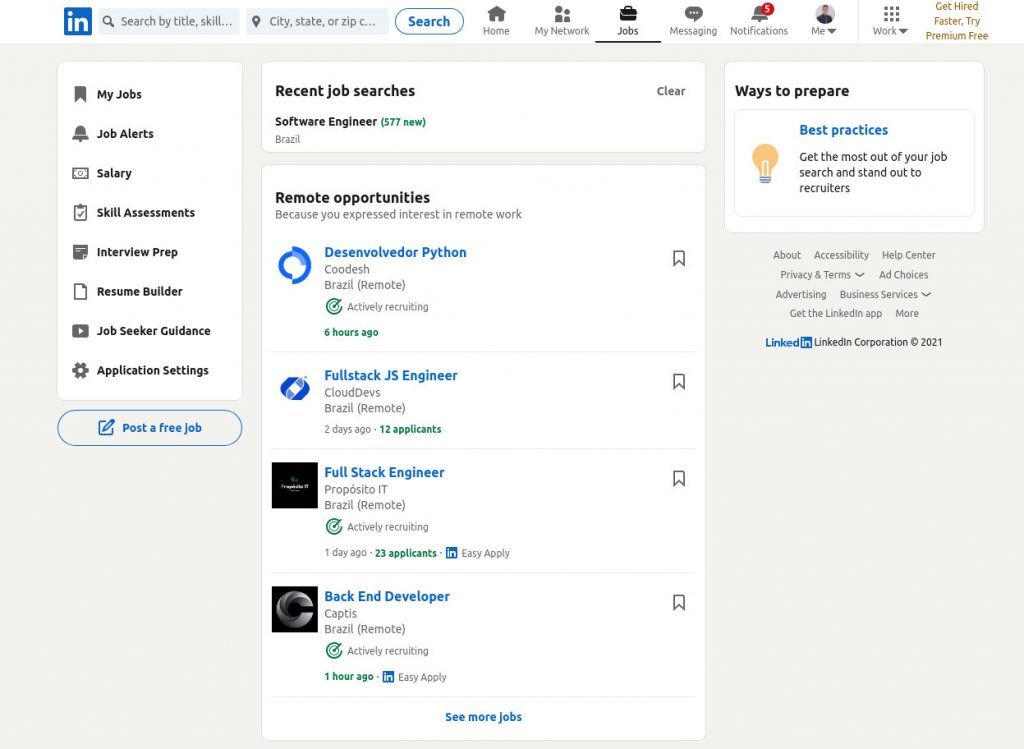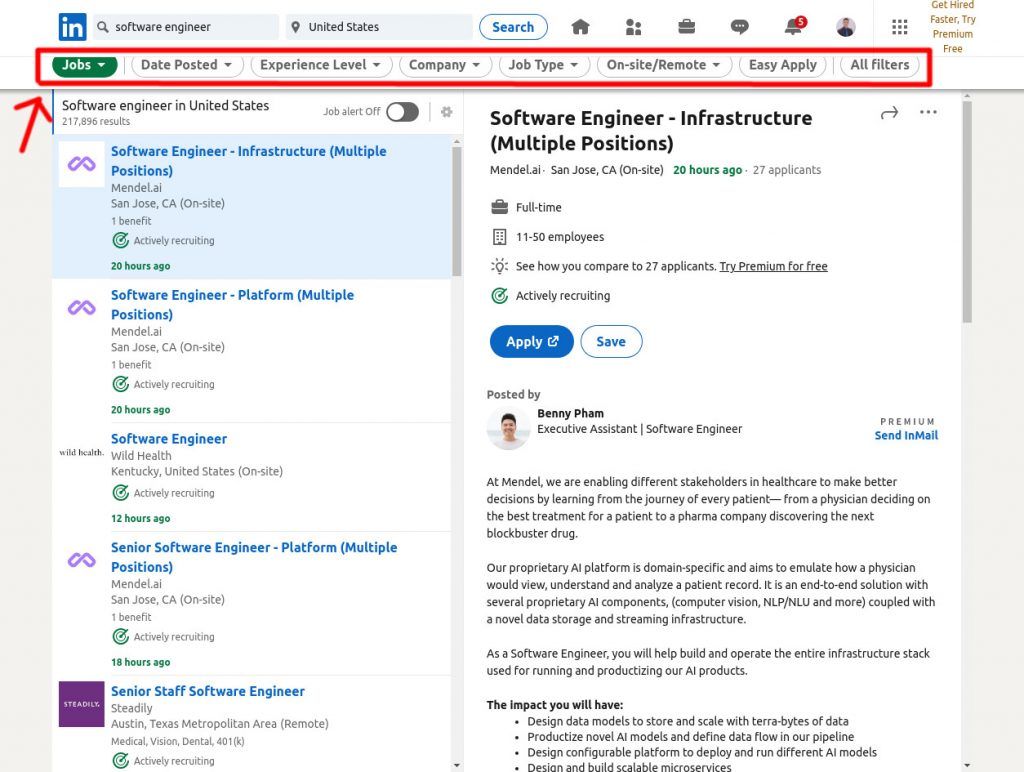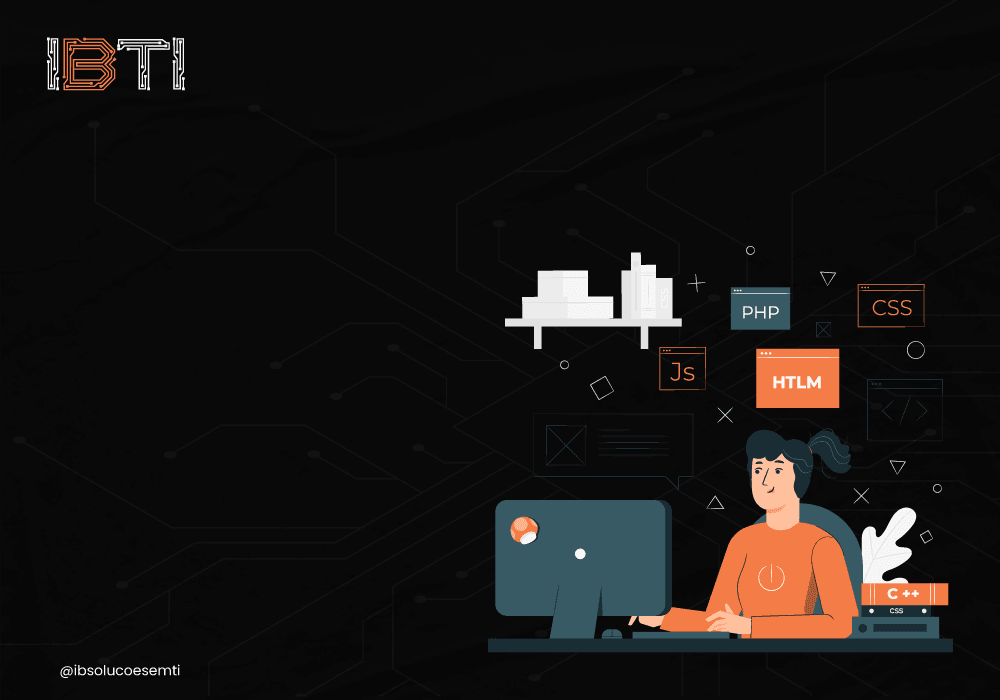How to work remotely and Earn Dollars with Programming – pt 2
 Igor Brandão#igorabrandao
Igor Brandão#igorabrandaoHow to knock on the right doors?
We mentioned in the previous post that searching for remote jobs in IT starts with Linkedin connections (if you missed post 1 of this series, click here to access it). In addition, you already know about the basic prerequisites to apply for a remote position (in the first post we guided you to the creation of your Linkedin profile in English). It is worth remembering to invest in details of your previous experiences, as well as taking the tests to validate your curriculum skills on LinkedIn.
Now it’s time to learn how to use LinkedIn Jobs [Fig. 1]. This is a tool that allows you to search for work or projects using a filter by region, area of expertise, technologies, etc (Fig.2). For example, I am applying the filters: a) remote position in Germany, b) senior-level, c) using Java programming language, or a) remote internship b) in Brazil c) using Phyton language.
Since the tool uses your Linkedin data, the user does not have to repeat all the information provided once. In other words, you can use your LinkedIn profile to apply to different Jobs: search for a job by positions and regions of interest (the tool also suggests different jobs according to your interests). If the job is interesting to you, apply to it and wait for the company’s response. Realistically, about 5-10% of companies will give you a return, so always try other options, don’t give up.
Fig 1. Linkedin Jobs home page

An important detail to mention here is the search filters [Fig. 2]. Use the different fields to filter the positions that interest you the most. For example: select only remote positions and positions from countries other than Brazil to find remote positions abroad.
Fig 3. Notification of LinkedIn Jobs alerts

Before talking about the selection process itself, here are some tips to help you find your expected remote job:
Tip 1: Pay attention to your English writing and formality when chatting to a recruiter. You can use Grammarly as an English correction tool (https://app.grammarly.com) and never send data in Portuguese, including your resume.
Tip 2: If your colleague works for a certain company you want to apply for, don’t be embarrassed: ask him/her for a recommendation to insert on your profile. Also, ask him/her to refer you to his/her company.
Tip 3: The Easy Apply tool allows you to submit your resume to a job position without registering your data on the company’s website again (unlike the “Apply Now” tool, in which LinkedIn redirects you to the company’s website for registration). Therefore, before selecting “Easy Apply”, make sure your resume is in the updated English version. (This does not mean that the company will not require future registration and subsequent interviews).
Tip 4: Remember to turn on the Job alert [Fig. 3].
Understanding the structure of a selection process
If the first contact with the company works, you will face the following process:
I) Interview with HR: The company will evaluate your ability to communicate in English, as well as your general professional experience. You can hear questions like:
- Comment about a project you participated in and you are proud of;
- What is the main challenge you have faced in your career?
- What are your main contributions to this specific project you participated in?
- What do you expect in your professional future?
- How can you contribute to achieving this specific goal?
- Comment on similar projects you’ve already developed
Answering interviewers’ questions require practice and technique. Access the link below to find out how to answer these and other questions and be successful in these interviews:
II) If the recruiter is interested in you, the next phase (usually) is technical and may include different formats, including:
a. Code challenge: in general, they are algorithms or data structures tests, which are done on platforms, such as Hackerrank and Leetcode. The person is evaluated on the ability to develop logical reasoning and algorithm under time pressure, bringing the best solution. Failing to answer a question is practically disqualifying here. Usually, big companies like Amazon and Google apply Code challenges (It is recommended to prepare yourself for the Amazon or Google test at least six months in advance). I also suggest talking to people who have already done these tests. If you don’t succeed on a first attempt, you may succeed on a second attempt. However, the company generally allows you to develop a new project (or a new test) only 6 months to 2 years after doing it for the first time. Therefore, it is worth asking the company for feedback to improve the requisites that may have resulted in your disqualification.
b. Project (take home): Here, you will face a short project or some specific module to be solved in a few days or a few hours. They will evaluate your ability to code in the technology of interest, as well as analyze your coding pattern (if you use the best programming practices, comment the code, format the code, etc). Your maturity regarding the project architecture is also evaluated (if you correctly use Object Orientation, design patterns, atomic design, etc). Not doing all the requisites requested in the project scope may not be disqualifying, but it is important to be aware of what is mandatory and what is optional.
c. Technical interview: Usually, this is a conversation with someone on the team who will ask you general questions (about projects you’ve developed in the past) and; or technical and specific questions, such as how to resolve collisions with Hashtable. These questions vary widely according to the company and interviewer.
d. Live-coding: This mode is one of the most challenging since you will need to solve a real problem while being viewed on your webcam and sharing your computer screen. The challenge can include writing pseudocodes to solve a simple algorithm or even creating modules for the company’s project. These codes also vary widely according to the company and evaluators.
III) Interview with the client: Depending on the company that is hiring you (outsourced or not), the last step is generally a conversation with the client or with the product team (this depends on the company structure and the project in which you will be allocated). When you reach this stage, you are very close to the end, but be very careful: always be prepared for the worst types of questions. Practicing is never too much, be confident in the interview and do your best, everything will be worth it in the end.
Second practical tip
If you missed the first practice tip
 Remote work
Remote workHow to work remotely and Earn Dollars with Programming – pt 1
Always prepare questions for the interviewers about the company. This demonstrates your interest and preparation for situations in which you are being evaluated. If you have notions about the project that the company is developing, it is also interesting to ask more specific questions related to this one.
Stay tuned for the next posts, where I’ll talk a little about the bureaucracies involved in working remotely for a foreign company.
If you like this post, have any comments or criticisms, leave your comment below and help us by sharing this content!
And that’s it for today guys, see you next time.
Cheers and stay well.

Igor Brandão
#igorabrandao🇧🇷 Português
Olá! Sou o Igor, analista de sistemas com mais de 10 anos de experiência em desenvolvimento de software. Tenho formação em Análise de Sistemas, TI e Administração, além de um Mestrado em Bioinformática. Apaixonado por criar soluções inteligentes e eficientes.
🇺🇸 English
Hello! I’m Igor, a systems analyst with over 10 years of experience in software development. I hold degrees in Systems Analysis, IT, and Business Administration, along with a Master’s in Bioinformatics. Passionate about building smart, efficient solutions.